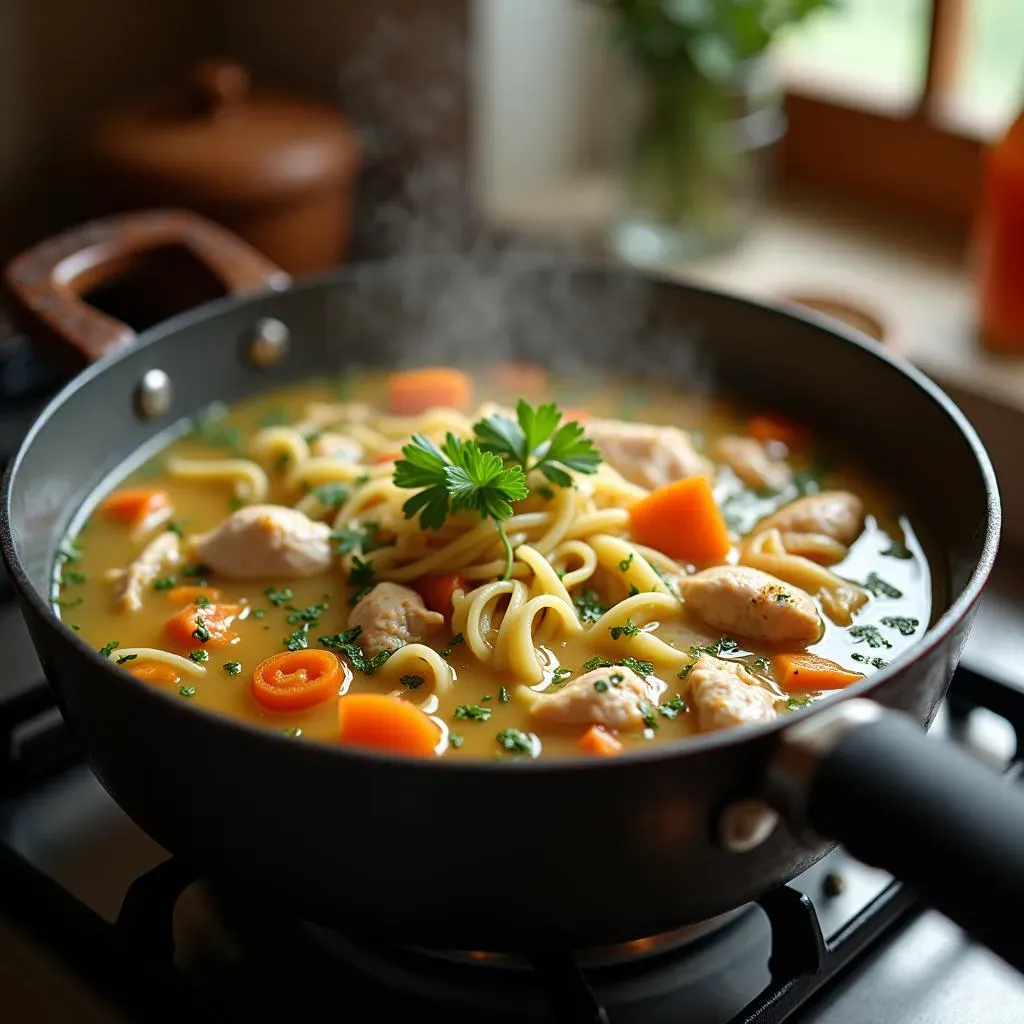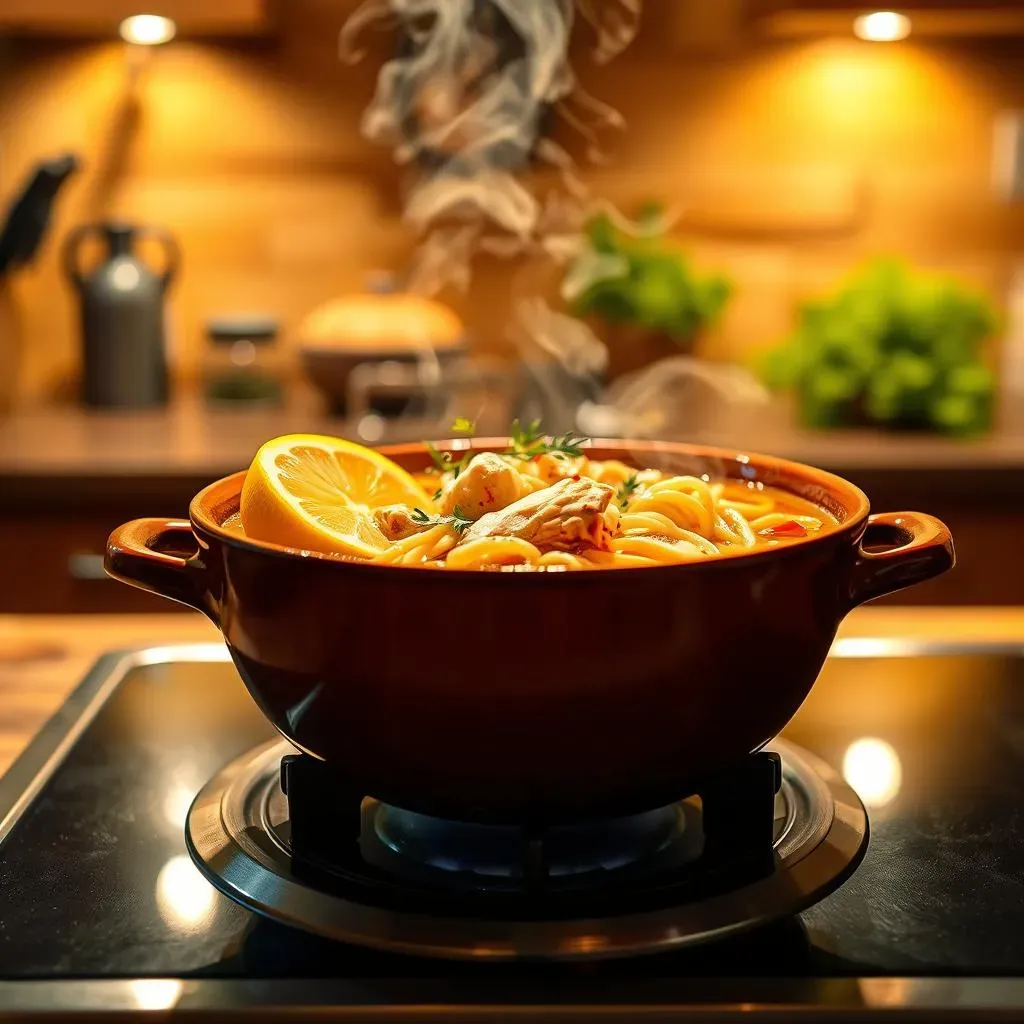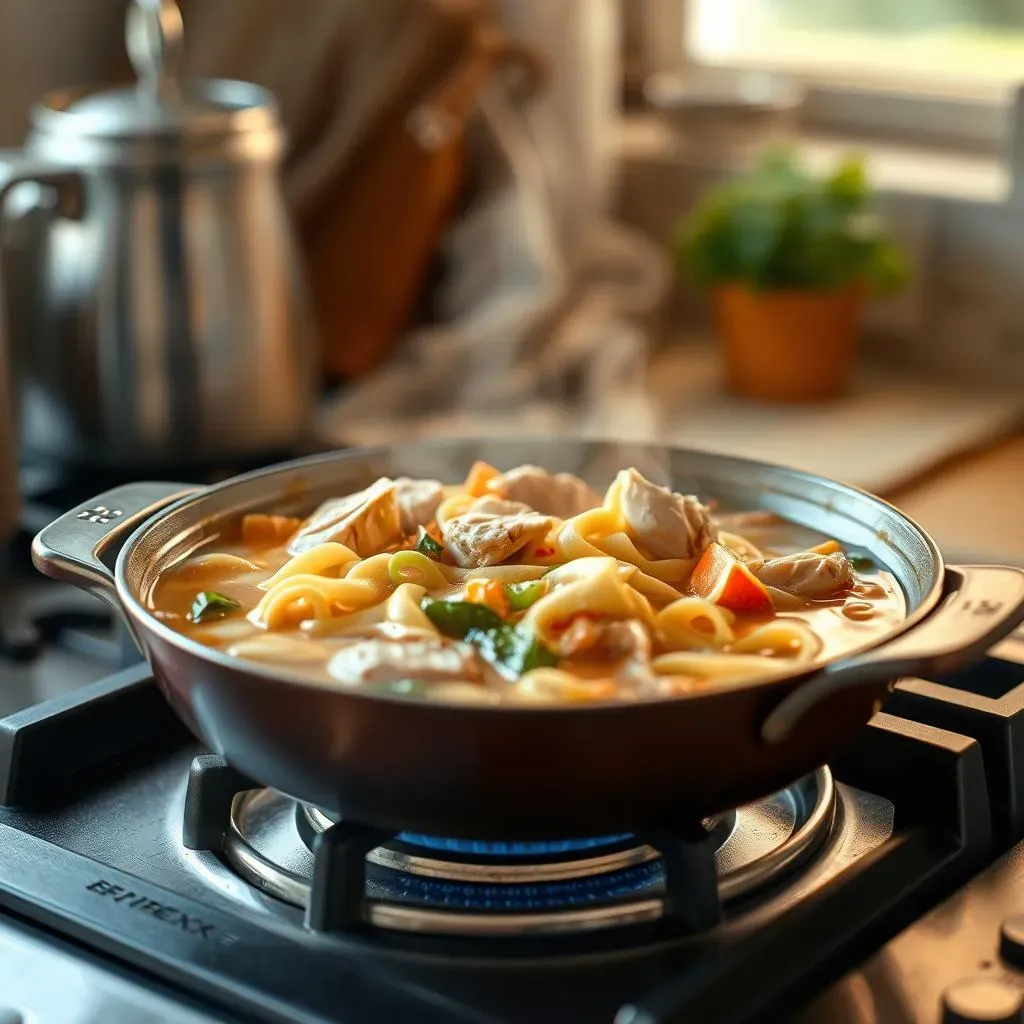Table of Contents
Craving comfort? Nothing beats a warm bowl of homemade chicken noodle soup. Forget the canned stuff, because today, I'm showing you how to make a truly delicious chicken noodle soup recipe on stove, right in your own kitchen. It's easier than you think, and I’m going to walk you through it, step by step. We'll start by talking about what makes a great soup, then we’ll dive into the actual cooking process. I'll share some of my favorite tips for getting the best flavor and texture, like how to avoid mushy noodles. Plus, I'll cover how to store leftovers and even some serving suggestions that will make your soup extra special. Get ready to learn how to create a chicken noodle soup recipe on stove that will become a family favorite. So grab your pot, and let's get cooking!
The Secret to Perfect Stovetop Chicken Noodle Soup

The Secret to Perfect Stovetop Chicken Noodle Soup
The Broth is King
Let's be real, the broth is where the magic happens. I mean, it's the soul of any good chicken noodle soup recipe on stove. You can't just throw some water in a pot and expect it to taste like grandma's. For a rich flavor, I like to start with bone-in chicken. The bones add a depth that you just can't get with boneless breasts alone. I usually use chicken thighs and drumsticks because they have more flavor and stay juicy while cooking. Don't be afraid to get a little messy and brown the chicken a bit before adding the liquid. That little bit of caramelization makes a huge difference in the final taste. Trust me on this one.
And don't forget the aromatics! Onions, carrots, and celery are your best friends here. I like to sauté them in a little butter or olive oil until they're soft and fragrant. This step releases their natural sweetness and creates a flavor base that'll make your soup sing. Garlic is also a must. Add it in the last minute of sautéing so it doesn't burn. These few simple steps will make the broth taste like it's been simmering all day, even when it hasn't.
Noodle Nirvana
Okay, let's talk noodles. Nobody likes a bowl of mushy, overcooked noodles in their soup. It’s a crime, I tell you, a culinary crime! The secret here is to cook them separately. I usually boil them in a separate pot of salted water until they're just al dente. Then, and this is the key, I rinse them with cold water to stop the cooking process. This prevents them from continuing to absorb the broth and becoming a gummy mess. When you're ready to serve, simply add the cooked noodles to the soup, and they'll be perfect every time. You can use any type of noodle you like, from classic egg noodles to fun shapes like rotini or ditalini, but my go-to is wide egg noodles because they hold up really well.
Here's a quick tip: If you're making a big batch of soup, you might want to store the noodles separately in the fridge, then add them to individual bowls when you are serving. That way the noodles will not get overcooked and soggy.
Ingredient | Why it Matters |
|---|---|
Bone-in Chicken | Adds depth of flavor to the broth |
Sautéed Aromatics | Creates a flavorful base |
Al dente Noodles | Prevents mushy soup |
Seasoning Sensations
Alright, the last piece of the puzzle: seasoning. Salt and pepper are the basics, but don't be shy about adding other herbs and spices. I like to add a bay leaf to the broth while it simmers. It adds a subtle complexity that you can't quite put your finger on. A little bit of fresh thyme or parsley will brighten things up. Remember, the goal is to enhance the natural flavors of the chicken and vegetables, not to overpower them. Taste as you go, and adjust your seasonings to your liking. Every single chicken noodle soup recipe on stove is different, so don’t be afraid to experiment. And just like a good workout, proper seasoning takes practice. Don’t be discouraged if you don’t get it perfect the first time.
StepbyStep Guide to Making Chicken Noodle Soup on the Stove

StepbyStep Guide to Making Chicken Noodle Soup on the Stove
Alright, let’s get down to business. You want to make a great chicken noodle soup, right? First, grab a big pot – you’ll need it. Now, toss in those bone-in chicken pieces. I like to use about 2 pounds for a good-sized batch. Don't overcrowd the pot; give the chicken some space so it can brown nicely. Brown the chicken in some olive oil or butter over medium-high heat for about 5-7 minutes, flipping halfway. This step will add a wonderful depth of flavor to your broth. Once it’s browned, remove the chicken and set it aside for now. It's time to add the aromatics, the holy trinity of onions, carrots, and celery – about one cup of each, chopped. Sauté them in the same pot with a bit more butter, or olive oil, until they soften, usually around 5 minutes. Add 2 cloves of minced garlic in the last minute, and let it get fragrant.
Next, pour in about 8 cups of chicken broth. You can use low-sodium store-bought broth, or if you're feeling ambitious, homemade broth is even better. Return the chicken to the pot. Add a bay leaf, a teaspoon of dried thyme, and salt and pepper to taste. Bring the soup to a boil, then reduce the heat to low, cover, and let it simmer for at least 45 minutes. This simmering time allows the flavors to meld together, and the chicken becomes incredibly tender. After the chicken has simmered, remove it from the pot and let it cool slightly. Once it’s cool enough to handle, shred the chicken using two forks. Discard the bones and skin. Now, add the shredded chicken back into the pot. Remember those noodles we talked about? Cook them separately, al dente, rinse with cold water, and add them to the soup just before serving. Garnish with some fresh parsley for a pop of color and flavor, and there you have it – a fantastic homemade chicken noodle soup recipe on stove.
Step | Action | Why |
|---|---|---|
1 | Brown Chicken | Adds depth of flavor |
2 | Sauté Aromatics | Builds the flavor base |
3 | Simmer with Broth | Melds the flavors and tenderizes chicken |
4 | Shred Chicken and add it back | Adds texture and flavor |
5 | Add Cooked Noodles | Prevents mushy noodles |
Tips for the Best Chicken Noodle Soup Recipe on Stove

Tips for the Best Chicken Noodle Soup Recipe on Stove
Alright, let's talk pro tips. You know, those little secrets that take a good chicken noodle soup recipe on stove and make it great. First off, don't skimp on the veggies. I mean, it's called chicken "and" noodle soup for a reason, right? So, don't just use the basic carrots, celery, and onions. Try adding some leeks or parsnips for extra depth of flavor. They bring a subtle sweetness that really complements the chicken. Also, don't be afraid to use fresh herbs. While dried herbs are okay, fresh herbs really make a difference. A handful of fresh parsley, thyme, or even some dill added at the end will brighten up the whole pot. And here's a trick I learned from my grandma: add a squeeze of lemon juice right before serving. It adds this incredible zing that makes all the other flavors pop. It’s like a little party in your mouth, I swear.
Another tip I swear by is to use quality broth. If you have the time, making your own chicken broth is definitely worth the effort. But if not, look for low-sodium options at the store. That way, you have more control over the saltiness of your soup. And, this one’s important, always taste as you cook. Don't just follow the recipe blindly. Taste the broth, add a little more salt, a little more pepper, a little more of whatever you think it needs. It’s your soup, make it exactly how you like it. And remember, cooking is like a science experiment, so don’t be afraid to get a little creative. Lastly, don’t be afraid to experiment with different types of noodles. Some people like thin vermicelli, others like thicker egg noodles. It’s all about personal preference. Find what you like and stick with it.
Tip | Why It Works |
|---|---|
Use a variety of veggies | Adds depth and complexity |
Fresh herbs | Brightens up the flavor |
Lemon juice | Adds a zingy touch |
Taste as you cook | Customize the flavor to your liking |
Storing and Serving Your Homemade Chicken Noodle Soup

Storing and Serving Your Homemade Chicken Noodle Soup
Keeping it Fresh
Okay, so you've made this amazing pot of chicken noodle soup recipe on stove, and now you’re wondering how to keep it fresh. Well, good news! Storing it is pretty easy. The best way to store your soup is to let it cool down completely. Once it's cooled, transfer it to airtight containers. I like to use glass containers, but any good quality plastic containers will do. If you’re planning on eating it within the next 3-4 days, you can just pop it in the fridge. But if you want to keep it longer, freezing is your best bet. When freezing, make sure you leave a little space at the top of the container because the soup will expand as it freezes. And here's a little tip: if you freeze it in individual portions, it makes for super easy and quick meals later on. It’s like having your own little soup delivery service, right in your freezer.
Now, one thing to keep in mind is that the noodles can sometimes get a little mushy when stored in the broth. So, if you're planning on freezing, it might be a good idea to store the noodles separately. Cook them al dente, then rinse them with cold water, and store them in a separate container in the fridge. You can then add the noodles to the soup when you reheat it. Trust me, it makes a big difference in texture.
Reheating and Reviving
So you’ve got your soup stored, now you need to reheat it. No problem! If you’re pulling it out of the fridge, you can simply reheat it on the stovetop over medium heat. Just stir it occasionally to make sure it heats evenly. If you’re reheating frozen soup, let it thaw overnight in the fridge first. You can also reheat frozen soup directly on the stovetop, but you’ll need to do it over low heat to make sure it doesn’t burn. You might also need to add a little bit of extra broth or water to loosen it up, as the soup can become a little thicker after freezing.
I always like to give it a little extra oomph when reheating. A sprinkle of fresh herbs, or a squeeze of lemon can revive the flavors. It's like giving your soup a mini-spa treatment. It brings it back to life and makes it taste as good as the first time you made it. And if you're feeling fancy, you can add a dollop of sour cream or a swirl of cream on top for a richer taste.
Storage Method | Timeframe | Tips |
|---|---|---|
Refrigerator | 3-4 days | Use airtight containers |
Freezer | Up to 3 months | Leave space for expansion, store noodles separately |
Serving Suggestions
Alright, you’ve got your soup heated, and now it’s time to serve it. Now, you could just pour it into a bowl and call it a day, but why not make it a little special? First, always serve it hot. I mean, it’s a warm bowl of comfort, so you want it to be nice and steamy. Garnish it with a sprinkle of fresh parsley, or chives, or even some dill. This adds a pop of color and a fresh flavor. If you’re feeling a little fancy, a swirl of cream or a dollop of sour cream can also be a great addition. And don’t forget the bread! A crusty baguette or some toasted garlic bread is the perfect accompaniment to a bowl of warm soup. It’s great for dipping and soaking up all of that delicious broth.
And here’s one more tip: don’t be afraid to experiment with toppings. Some people like to add a sprinkle of red pepper flakes for a little bit of heat, while others like to add a dollop of pesto for an extra layer of flavor. And if you're feeling really adventurous, try adding some crispy fried onions. It adds a nice crunch and a savory taste. So get creative, and have fun with it. Remember, it’s your soup, so you can serve it however you like it.
The Last Sip: Mastering Your Stovetop Chicken Noodle Soup
And there you have it, a fantastic chicken noodle soup recipe on stove, ready to warm you from the inside out. From prepping the veggies to that final, satisfying slurp, you've now got the skills to whip up this classic comfort food anytime. Remember, the best part about cooking is making it your own, so don't be afraid to tweak the recipe, add your favorite herbs, or experiment with different veggies. So go forth, soup masters, and enjoy the delicious results of your hard work. Now if you’ll excuse me, I think I need another bowl.
